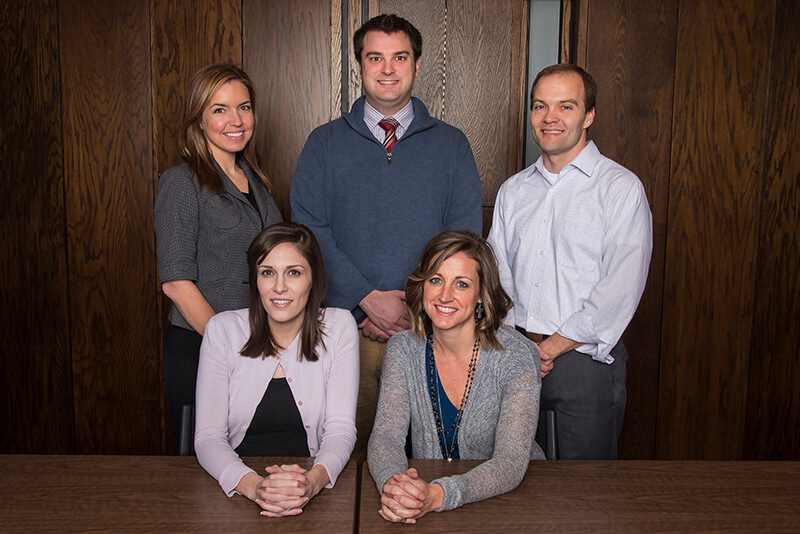March 20, 2017
Efforts to transform Purdue business: A BPR overview
 Business Process Reengineering team members (front row, from left) Melanie Bell, Whitney Beutel, (back row, from left) Amber Thompson, Nathan Manges and Andrew Bean. (Purdue University photo/Rebecca Wilcox)
Download image
Business Process Reengineering team members (front row, from left) Melanie Bell, Whitney Beutel, (back row, from left) Amber Thompson, Nathan Manges and Andrew Bean. (Purdue University photo/Rebecca Wilcox)
Download image
By now, most members of the Purdue community have heard about the University's Business Process Reengineering projects, which were established with a goal to simplify, streamline, automate and organize business processes and related systems. Tim Werth, BPR director, is leading these projects with a talented team of Purdue staff complemented by external consulting partners.
"Our charge from the beginning has been to create world-class business processes to support our world-class research, teaching and engagement," Werth says. "When we look at our current processes, they don't meet our institution's needs, so we are working to change that."
The "discovery phase" of BPR kicked off in mid-2016 and consisted of collecting, organizing and documenting business processes. The BPR team met with hundreds of employees to gather firsthand perspectives, "pain points" and ideas for making processes more effective.
The result of this discovery phase was to create three linked projects in the following areas:
* General Ledger, with team leader Eva Nodine.
* Human Capital Management, with team leader Linda Baer.
* Enterprise Asset Management, with team leader John Higgins.
"We discovered more than 1,400 processes covering the spectrum of general ledger, human capital management and enterprise asset management," Werth says. "We found inconsistency and a lack of standardization across units as well as duplication of efforts. We came away with several goals -- to eliminate paper-based processes, reduce manual reconciliations, and streamline, automate and standardize the workflow."
The "design phase," which began in late November 2016 and is still underway, consists of workshops focused on designing processes based on feedback, best practices and enabling technology that relate to those three main project areas.
"The workshops are bringing together project team members, our consultants and experts from across the Purdue community to gather information, ask difficult questions and really challenge the way we've been operating so we can redesign processes for further prototyping, testing and ultimately implementation," Baer says.
Werth adds: "Projects of this nature and the related process redesign efforts are part of a continuous improvement loop. The initial workshops are yielding results that will be checked and adjusted as our team and stakeholders evaluate the impact on our organization and business requirements."
In an effort to be most successful, a special team was created to collect information during the discovery phase, and members of that team are now aligned with each project to measure improvements and successes. Team members and there areas of focus are:
* Amber Thompson, BPR manager.
* Andrew Bean, working with finance.
* Whitney Beutel, working with finance.
* Melanie Bell, working with human capital management.
* Nathan Manges, working with enterprise asset management.
They help the project teams specifically look for efficiencies. From design phase to implementation, they are documenting and analyzing improvements. Questions such as "Were any processes eliminated? Did we remove paper, the need to rely on Excel, redundancies or effort?" are asked and analyzed by the team. They work closely with the project director and project leads of each team, comparing today’s processes vs. future to-be processes, and providing progress reports along the way.
In addition to supporting the transformation projects, this team is often charged with analyzing processes brought forward as "pain points." Pain points submitted through the website are forwarded to the BPR team.
"As we work through these transformations, it is important to keep in mind that within the scope of our projects, not every University process and every pain point shared will be reengineered," Werth says. "We are, however, making great strides in a direction that will positively impact how business is done overall in regards to general ledger, human capital management and enterprise asset management. Our success is dependent on thoughtful feedback from the Purdue community and a shared and active ownership of this transformation. We believe life will be better, but we need others to believe and actively work with us to achieve our goal."
According to Werth, implementation of new business processes and related technologies will be phased in starting in fall 2017 with capital projects and plant maintenance. Human capital management processes are slated to follow in early 2018, and finance processes are expected in summer 2018.
More on the transformation
This article is the first in a series to highlight the different areas and BPR team members. Each project area will be showcased in separate articles to provide additional insight to the projects and people working behind the scenes to make the end results successful.
* Explore the website for an overview of the transformation projects.
* Provide feedback by submitting a pain point, completing a survey or sending an email.
* View previous presentations and publications for more information.
* See the December 2016 HR Connect article - BPR: A journey in business, personal transformation.

